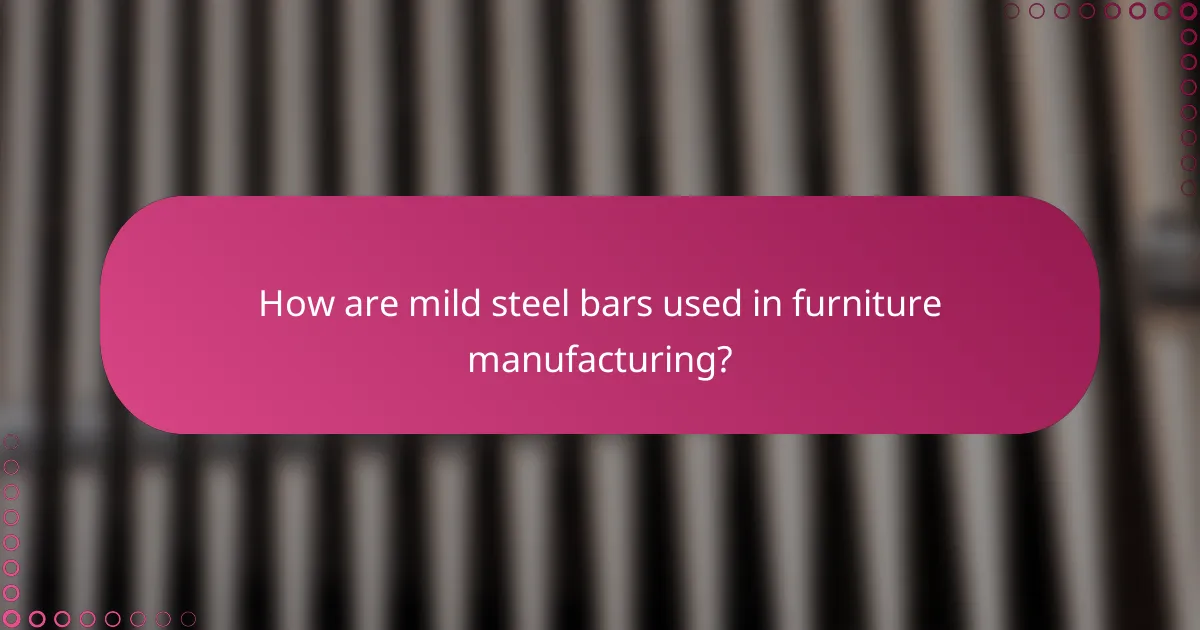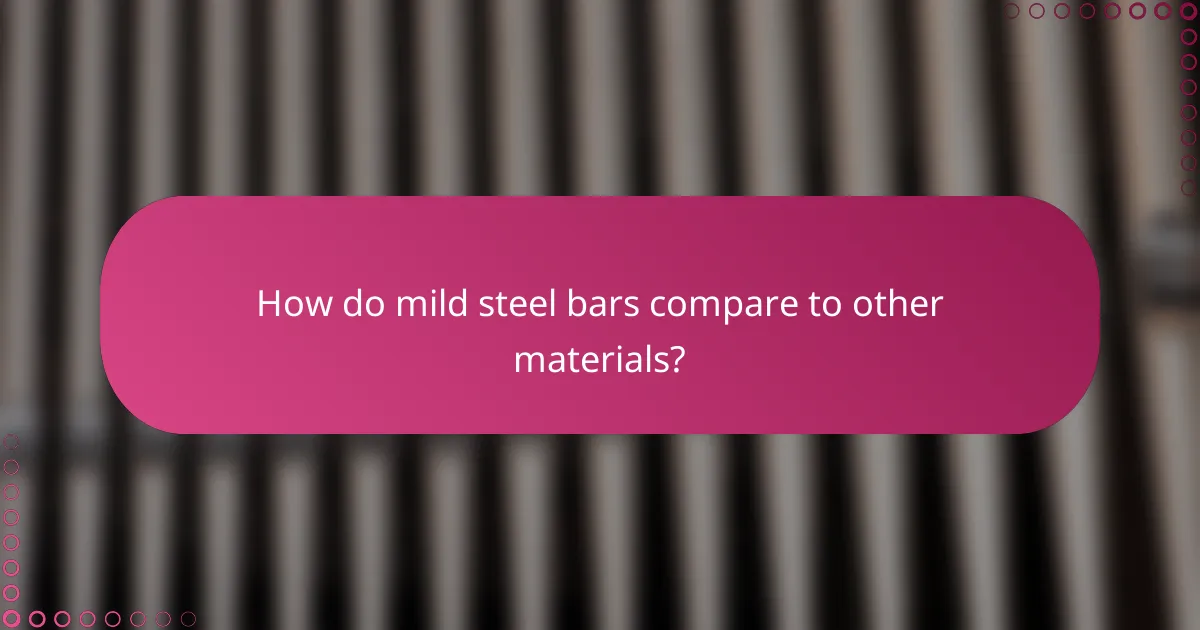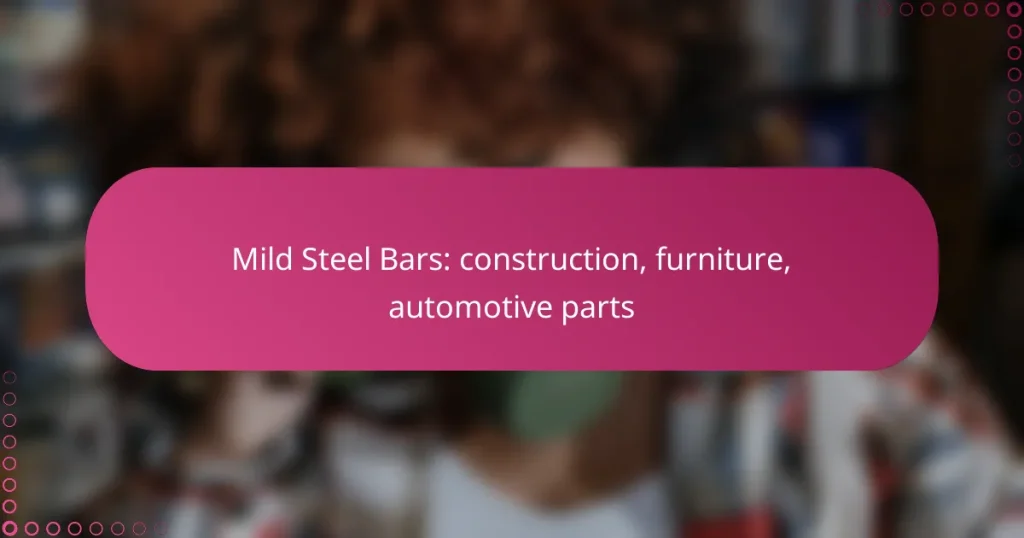Mild steel bars are essential materials in various industries, including construction, furniture manufacturing, and automotive parts. Known for their strength, flexibility, and cost-effectiveness, they provide structural integrity and durability in buildings, serve as versatile components in furniture, and contribute to the lightweight design of automotive components.

What are the best applications of mild steel bars in construction?
Mild steel bars are widely used in construction due to their strength, flexibility, and cost-effectiveness. They play a crucial role in various structural applications, ensuring durability and stability in buildings and infrastructure.
Structural support beams
Mild steel bars are commonly utilized as structural support beams in buildings, providing essential load-bearing capabilities. Their high tensile strength allows them to support significant weight, making them ideal for both residential and commercial structures.
When selecting mild steel for support beams, consider factors such as span length and load requirements. Typically, beams are designed to meet specific building codes, which may vary by region.
Reinforcement in concrete
Mild steel bars are integral to reinforcing concrete, enhancing its tensile strength and overall durability. They are often embedded within concrete slabs and walls to prevent cracking and structural failure.
In construction, the use of mild steel reinforcement bars, or rebar, is guided by standards such as ASTM A615 in the United States. Proper placement and spacing of rebar are crucial to achieving optimal strength and compliance with local regulations.
Framework for buildings
The framework of buildings often incorporates mild steel bars to create a robust skeleton that supports walls and roofs. This framework can be prefabricated or constructed on-site, depending on project requirements.
When designing a framework, engineers must account for factors like load distribution and environmental conditions. Using mild steel allows for flexibility in design while maintaining structural integrity.
Bridges and infrastructure
Mild steel bars are essential in the construction of bridges and other infrastructure projects, providing the necessary strength to withstand heavy traffic loads and environmental stresses. Their corrosion resistance can be enhanced with protective coatings for longevity.
In bridge construction, the design often includes a combination of mild steel and concrete to optimize performance. Compliance with local engineering standards is critical to ensure safety and durability in these critical structures.

How are mild steel bars used in furniture manufacturing?
Mild steel bars are commonly used in furniture manufacturing due to their strength, versatility, and cost-effectiveness. They serve as structural components and decorative features, making them ideal for various furniture applications.
Frames for chairs and tables
Mild steel bars provide robust support for the frames of chairs and tables, ensuring stability and longevity. The material can be easily shaped and welded, allowing for intricate designs while maintaining structural integrity.
When designing frames, consider the thickness of the steel bars; typically, a thickness of around 1.5 to 3 mm is effective for most furniture applications. This range balances strength and weight, making the furniture easier to handle and move.
Decorative elements
In addition to structural uses, mild steel bars are often utilized as decorative elements in furniture design. They can be finished with various coatings, such as powder coating or paint, to enhance aesthetics and protect against corrosion.
Examples include steel accents on tables or artistic chair backs, which add a modern touch to traditional designs. When incorporating decorative elements, ensure that the finishes are suitable for the intended environment, such as indoor or outdoor use.
Durability and design flexibility
Mild steel bars are known for their durability, making them a preferred choice for furniture that withstands daily use. Their ability to be easily manipulated allows designers to create unique shapes and styles that cater to diverse consumer preferences.
However, it is essential to consider the potential for rust if the furniture is exposed to moisture. Using protective coatings and selecting appropriate designs can mitigate this risk, ensuring that the furniture remains both functional and visually appealing over time.

What role do mild steel bars play in automotive parts?
Mild steel bars are essential in automotive parts due to their strength, ductility, and cost-effectiveness. They are commonly used in various components, providing structural integrity and durability while remaining relatively lightweight.
Chassis components
Mild steel bars are frequently utilized in the construction of chassis components, which form the backbone of a vehicle’s structure. Their high tensile strength allows them to withstand significant loads and stresses encountered during operation.
Common chassis elements made from mild steel include cross members, frame rails, and support brackets. These components must meet specific safety standards, ensuring they can endure impacts and maintain vehicle stability.
Suspension systems
In suspension systems, mild steel bars are used to create parts such as control arms, sway bars, and coil spring seats. These components are crucial for maintaining vehicle handling and ride comfort by absorbing shocks and vibrations from the road.
When selecting mild steel for suspension parts, consider factors like corrosion resistance and weight. Some manufacturers may apply protective coatings to enhance durability, especially in regions with harsh weather conditions.
Engine mounts
Mild steel bars are also integral to engine mounts, which secure the engine to the vehicle’s frame while minimizing vibrations. The strength of mild steel ensures that these mounts can support the engine’s weight and withstand the forces generated during operation.
Proper design and fabrication of engine mounts using mild steel can prevent excessive movement and noise, contributing to a smoother driving experience. Regular inspections are recommended to check for wear and tear, ensuring continued performance and safety.

What are the key benefits of using mild steel bars?
Mild steel bars offer several advantages in construction, furniture making, and automotive parts manufacturing. Their affordability, strength, and ease of fabrication make them a popular choice across various industries.
Cost-effectiveness
Mild steel bars are generally more affordable compared to other types of steel and materials. This cost-effectiveness is particularly beneficial for large-scale construction projects where budget constraints are common.
When considering the use of mild steel bars, it is essential to evaluate the total cost, including fabrication and installation. In many cases, the lower initial material cost can lead to significant savings in overall project expenses.
High tensile strength
Mild steel bars possess high tensile strength, making them suitable for applications that require durability and resistance to deformation. This characteristic is crucial in construction and automotive parts, where structural integrity is paramount.
The tensile strength of mild steel typically ranges from 370 to 700 MPa, depending on the specific grade. This strength allows mild steel bars to withstand heavy loads and stresses, ensuring long-lasting performance in various applications.
Ease of fabrication
Mild steel bars are easy to work with, allowing for straightforward cutting, welding, and shaping. This ease of fabrication is advantageous in both construction and furniture design, where custom shapes and sizes are often required.
When fabricating mild steel bars, using standard tools and techniques can streamline the process. Familiarity with local regulations and standards can also help ensure compliance and quality in the final product.

What factors should be considered when selecting mild steel bars?
When selecting mild steel bars, consider factors such as grade, dimensions, weight, and corrosion resistance. These elements significantly influence the performance and suitability of the bars for specific applications in construction, furniture, and automotive parts.
Grade and specifications
The grade of mild steel bars is crucial as it determines their mechanical properties and suitability for various applications. Common grades include S235, S275, and S355, each offering different yield strengths and tensile properties. It’s essential to choose a grade that meets the structural requirements of your project.
Specifications may also include standards such as ASTM A36 or EN 10025, which outline the chemical composition and mechanical properties. Always verify that the selected grade complies with relevant industry standards to ensure safety and performance.
Dimensions and weight
Dimensions of mild steel bars typically range from 6 mm to 50 mm in diameter, with lengths often available in standard sizes of 6 meters or more. The weight of the bars is directly proportional to their size, impacting transportation and handling costs. For example, a 12 mm diameter bar weighs approximately 0.888 kg per meter.
When selecting dimensions, consider the load-bearing requirements and space constraints of your application. Using a weight calculator can help estimate the total weight for budgeting and logistics purposes.
Corrosion resistance
Mild steel bars are generally susceptible to corrosion, which can compromise their structural integrity over time. To enhance corrosion resistance, consider using galvanized or coated bars, which provide a protective layer against environmental factors. This is particularly important in outdoor or humid applications.
Regular maintenance and protective treatments can also prolong the lifespan of mild steel bars. For instance, applying a rust-inhibiting paint can be a cost-effective way to protect the bars in furniture or automotive applications.

How do mild steel bars compare to other materials?
Mild steel bars are often favored for their strength, ductility, and cost-effectiveness compared to other materials. While they excel in construction and automotive applications, their performance can vary significantly when compared to alternatives like stainless steel and aluminum.
Versus stainless steel
Mild steel bars are generally less expensive than stainless steel, making them a popular choice for budget-conscious projects. However, stainless steel offers superior corrosion resistance and strength, which is crucial for applications exposed to moisture or harsh environments. For example, in outdoor furniture or marine applications, stainless steel may be the better option despite its higher cost.
When choosing between mild steel and stainless steel, consider the environment and required durability. Mild steel can be treated with coatings to improve its resistance to rust, but these treatments may require maintenance over time. In contrast, stainless steel’s inherent properties often eliminate the need for additional protective measures.
Versus aluminum
Mild steel bars are heavier than aluminum, which can be a disadvantage in applications where weight is a critical factor, such as in automotive parts. However, mild steel typically provides greater tensile strength, making it suitable for load-bearing structures. For instance, in construction, mild steel is often preferred for beams and reinforcements due to its robustness.
Aluminum, while lighter and resistant to corrosion, can be more expensive and less strong than mild steel. When deciding between the two, assess the specific requirements of your project, including weight limits, strength needs, and budget constraints. In many cases, mild steel is a practical choice for structural applications, while aluminum may be better suited for lightweight or aesthetic components.


